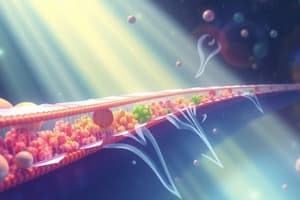Podcast
Questions and Answers
Which type of protein spans across the lipid bilayer and is involved in transportation?
Which type of protein spans across the lipid bilayer and is involved in transportation?
- Extrinsic Proteins
- Transmembrane Proteins
- Integral Proteins (correct)
- Peripheral Proteins
What primary function do peripheral proteins NOT perform?
What primary function do peripheral proteins NOT perform?
- Cell Recognition
- Osmosis (correct)
- Signal Transduction
- Structural Support
In terms of cellular transport, what accurately distinguishes osmosis from diffusion?
In terms of cellular transport, what accurately distinguishes osmosis from diffusion?
- Diffusion occurs under all conditions while osmosis requires a selective membrane. (correct)
- Osmosis creates a volume change, whereas diffusion does not.
- Osmosis involves solute movement while diffusion does not.
- Diffusion can occur in both water and solute while osmosis occurs only in water.
Which of the following statements about primary active transport is incorrect?
Which of the following statements about primary active transport is incorrect?
What is the primary role of secondary active transport?
What is the primary role of secondary active transport?
How does simple diffusion primarily differ from facilitated diffusion?
How does simple diffusion primarily differ from facilitated diffusion?
Which of the following factors influences the rate of simple diffusion?
Which of the following factors influences the rate of simple diffusion?
What characteristic is common to both facilitated diffusion and active transport?
What characteristic is common to both facilitated diffusion and active transport?
Which statement accurately reflects the relationship between osmotic pressure and water movement?
Which statement accurately reflects the relationship between osmotic pressure and water movement?
What is the primary function of cholesterol in the plasma membrane?
What is the primary function of cholesterol in the plasma membrane?
Which element is most abundant in extracellular fluid (ECF)?
Which element is most abundant in extracellular fluid (ECF)?
What structural feature of phospholipids contributes to the formation of the lipid bilayer?
What structural feature of phospholipids contributes to the formation of the lipid bilayer?
In which body fluid compartment do red blood cells reside?
In which body fluid compartment do red blood cells reside?
What characteristic of the plasma membrane allows for selective permeability?
What characteristic of the plasma membrane allows for selective permeability?
Which of the following statements about intracellular fluid (ICF) is true?
Which of the following statements about intracellular fluid (ICF) is true?
How does the lipid bilayer structure impact membrane fluidity?
How does the lipid bilayer structure impact membrane fluidity?
What is the primary role of glycolipids in the plasma membrane?
What is the primary role of glycolipids in the plasma membrane?
Which of the following ions is primarily found in high concentrations within intracellular fluid (ICF)?
Which of the following ions is primarily found in high concentrations within intracellular fluid (ICF)?
What is the main significance of the plasma membrane's semi-permeable nature?
What is the main significance of the plasma membrane's semi-permeable nature?
What is the primary function of facilitated diffusion carriers?
What is the primary function of facilitated diffusion carriers?
Which of the following is NOT a type of active transport carrier?
Which of the following is NOT a type of active transport carrier?
Which process requires energy to transport molecules across a membrane?
Which process requires energy to transport molecules across a membrane?
What defines the transport maximum (Tm) in carrier-mediated transport?
What defines the transport maximum (Tm) in carrier-mediated transport?
How do co-transporters function in active transport?
How do co-transporters function in active transport?
What is a characteristic of active transport carriers compared to facilitated diffusion carriers?
What is a characteristic of active transport carriers compared to facilitated diffusion carriers?
Which statement about secondary active transport is correct?
Which statement about secondary active transport is correct?
What type of transport involves moving molecules in opposite directions across the membrane?
What type of transport involves moving molecules in opposite directions across the membrane?
Which carrier primarily facilitates the uptake of glucose based on its concentration gradient?
Which carrier primarily facilitates the uptake of glucose based on its concentration gradient?
Which mechanism results in the passive transport of molecules across the membrane?
Which mechanism results in the passive transport of molecules across the membrane?
What is the primary role of integral membrane pores in transport?
What is the primary role of integral membrane pores in transport?
Which statement accurately describes the energy requirements for carrier proteins?
Which statement accurately describes the energy requirements for carrier proteins?
How do gated-ion channels operate to facilitate ion transport?
How do gated-ion channels operate to facilitate ion transport?
What distinguishes leak-ion channels from gated-ion channels?
What distinguishes leak-ion channels from gated-ion channels?
Which example illustrates the function of pores in membrane transport?
Which example illustrates the function of pores in membrane transport?
What is the main function of integral membrane channels?
What is the main function of integral membrane channels?
What is the characteristic feature of carriers as integral membrane proteins?
What is the characteristic feature of carriers as integral membrane proteins?
Which type of transport predominantly involves integral membrane proteins with no energy requirement?
Which type of transport predominantly involves integral membrane proteins with no energy requirement?
How do ion channels contribute to cellular activity?
How do ion channels contribute to cellular activity?
What kind of transport is facilitated by integral membrane proteins without the use of ATP?
What kind of transport is facilitated by integral membrane proteins without the use of ATP?
Flashcards are hidden until you start studying
Study Notes
Carrier-Mediated Transport
- Carriers bind to specific molecules on one side of the membrane, change shape, and release the molecule on the opposite side.
- Transport can be categorized as facilitated diffusion or active transport.
Types of Carriers
-
Facilitated Diffusion Carriers
- Assist in passive movement along concentration gradients without energy.
- Example: Glucose transporter (GLUT) facilitates glucose uptake based on concentration.
-
Active Transport Carriers
- Move molecules against their concentration gradient using energy (ATP).
- Primary Active Transport: Directly uses ATP to pump molecules.
- Examples: Na+ K+ ATPase, Ca2+ ATPase, H+ K+ ATPase (proton pump).
- Secondary Active Transport: Utilizes energy from electrochemical gradients established by primary active transport.
- Co-Transporters (symports): Move two molecules in the same direction.
- Counter-Transporters (antiporters): Move two molecules in opposite directions.
Body Fluid Compartments
- The body comprises approximately 55-60% fluid; the rest is solid tissue.
- All cells are surrounded by extracellular fluid (ECF).
- ECF Composition: High in Na+, Cl-, Ca2+, HCO3-.
- Intracellular Fluid (ICF): High in K+ and free proteins.
Plasma Membrane Structure
- Acts as a barrier, gateway for communication, and regulator of homeostasis.
- Composed of three key lipids: phospholipids, cholesterol, and glycolipids.
Lipid Bilayer
- Formed mainly of phospholipids with a hydrophilic head and hydrophobic tails.
- Creates a semi-permeable barrier that ensures selective substance entry and exit.
- Fluidity is essential for molecule movement and proper functioning of membrane proteins.
Cholesterol's Role
- Found interspersed within the lipid bilayer.
- Regulates membrane fluidity:
- High temperatures: Prevents excessive fluidity.
- Low temperatures: Prevents rigidity, maintaining flexibility.
Associated Proteins
- Integral Proteins: Span the membrane, involved in transport (e.g., pores, channels, carriers).
- Peripheral Proteins: Loosely attached to the membrane, involved in signal transduction and structural support.
Cellular Homeostasis
- The selective permeability of the membrane regulates internal environments, ion concentrations, and nutrient/waste transport.
Diffusion vs. Osmosis
- Diffusion: Passive movement from high to low concentration using kinetic energy; does not change volume.
- Osmosis: Water movement across a semi-permeable membrane towards higher solute concentration, causing volume changes.
Transport Mechanisms and Kinetics
- Simple Diffusion: Passive, concentration-driven, without saturation; influenced by permeability, temperature, and surface area.
- Facilitated Diffusion: Uses integral proteins for passive transport down the concentration gradient; no energy expenditure.
- Primary Active Transport: ATP-dependent, moves solutes against gradients; can reach saturation.
- Secondary Active Transport: Gradient-driven; co-transports solutes against gradients, influenced by electrochemical gradients.
Functions of Integral Membrane Proteins
-
Pores: Provide non-selective passages for small molecules like water or ions; facilitate simple diffusion; no energy required.
-
Channels:
- Leak-Ion Channels: Always open, allow passive ion movement; energy not required.
- Gated-Ion Channels: Open in response to stimuli (voltage, chemical, mechanical); facilitate passive movement; energy not required.
-
Carriers (Transporters): Require at least two gates for function, facilitating both facilitated diffusion and active transport.
Studying That Suits You
Use AI to generate personalized quizzes and flashcards to suit your learning preferences.




